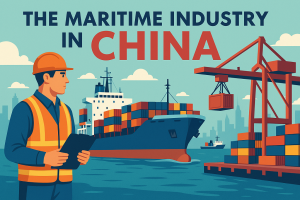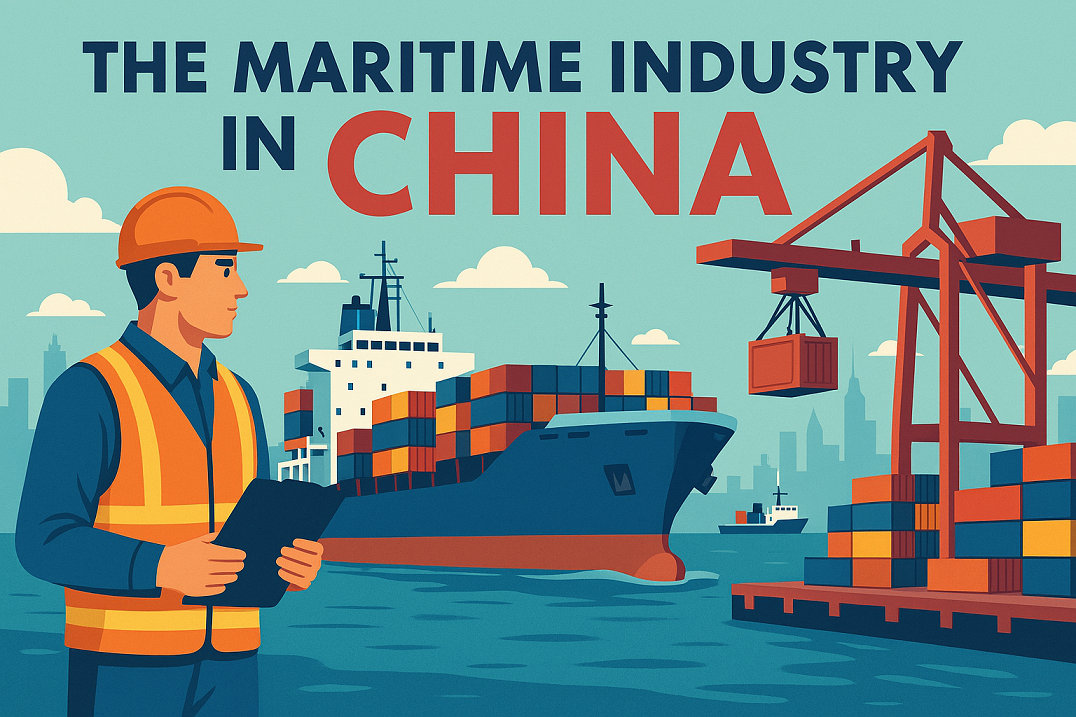Explore China’s dominant role in the global maritime industry—covering shipbuilding, shipping, ports, marine technology, and maritime education. A must-read for students, professionals, researchers, and general readers.
China and the Sea—A 21st Century Maritime Giant
Did you know that China builds more than 70% of the world’s ships and produces over 96% of global shipping containers? With seven of the world’s ten busiest ports and a rapidly expanding fleet, China has become a maritime superpower shaping global trade, technology, and training.
Whether you’re an aspiring seafarer, a logistics analyst, a policymaker, or just a curious learner, understanding China’s maritime sector is essential to grasp the future of global shipping.

1. China’s Role in Global Shipping and Maritime Trade
China is at the center of international maritime trade, backed by powerful infrastructure and global policy strategies.
Digital Silk Road & Belt and Road Initiative (BRI)
The Digital Silk Road, a branch of the BRI, aims to create seamless port connectivity and data-driven shipping routes across Asia, Africa, and Europe.
Key digital transformations:
-
Implementation of Electronic Data Interchange (EDI) systems
-
Smart port projects enhancing trade efficiency
-
Global interest in China’s Data Security Law, which affects access to AIS data (Automatic Identification System)
📚 For an overview of ship maneuvering technologies, see: How a Ship Is Maneuvered In and Out of Port
China’s Shipping Container Dominance
China is the undisputed leader in container production, with companies like China International Marine Containers (CIMC) supplying the vast majority of the world’s inventory.
Common search queries include:
-
“Where are shipping containers made?”
-
“Why does China dominate container production?”
2. Port Operations: China’s Global Trade Hubs
China’s port network is a model of high-volume, tech-driven efficiency.
World-Leading Ports
Among the top 10 busiest ports globally, seven are in China, including:
-
Port of Shanghai (world’s busiest)
-
Port of Ningbo-Zhoushan
-
Port of Shenzhen
-
Port of Guangzhou
These mega-ports handle hundreds of millions of TEUs (Twenty-foot Equivalent Units) annually, serving as gateways for global supply chains.
Digital Port Management
China’s investment in smart port infrastructure includes:
-
Automated cranes and robotics
-
AI-powered cargo management systems
-
Integration with the Beidou satellite network for maritime surveillance
🔗 Learn about Port Operations and Management for a deeper understanding of how ports function worldwide.
3. China’s Leadership in Shipbuilding
China is not just building more ships—it’s building smarter, cleaner, and more advanced ships than ever before.
Dominance in Global Shipbuilding Orders
China commands over 70% of the global shipbuilding market, especially in:
-
Container ships
-
Tankers
-
LNG and LPG carriers
Green and High-Tech Shipbuilding
Key innovations in Chinese shipyards:
-
Hybrid propulsion systems for low-emission operations
-
Electric and methanol-powered ships
-
Hull designs to reduce drag and fuel consumption
Prominent shipbuilders include:
-
Yangzijiang Shipbuilding Group
-
CSSC (China State Shipbuilding Corporation)
-
COSCO Shipping Heavy Industry
💡 Interested in sustainable marine engineering? Visit: Decarbonization and Maritime Education
4. Maritime Education and Training in China
With over 75 maritime education and training (MET) institutions, China is actively preparing the next generation of global seafarers.
STCW-Aligned Seafarer Programs
China’s MET programs are compliant with STCW (Standards of Training, Certification, and Watchkeeping) standards and include:
-
Engine and navigation officer training
-
Simulator-based courses
-
Onboard cadet training aboard dedicated training ships
Top institutions include:
-
Shanghai Maritime University
-
Dalian Maritime University
-
Wuhan University of Technology
Popular searches:
-
“STCW training in China”
-
“Chinese maritime academies ranking”
⚓ Explore Maritime English and Officer Training for insight into international training approaches.
Contribution to the Global Labor Market
China is emerging as a significant supplier of seafarers, rivaling traditional countries like the Philippines and India. This is reflected in rising numbers of Chinese cadets being deployed on international vessels.
5. Marine Technology and Environmental Innovations
China’s maritime technology sector is evolving fast to align with IMO’s decarbonization goals.
Hybrid Propulsion & Green Systems
China leads in:
-
Hybrid-electric propulsion market growth
-
Production of low-NOx and zero-emission marine engines
-
Research into hydrogen fuel cells and wind-assisted propulsion
Smart Marine Equipment
Ongoing innovations include:
-
AI-based route optimization
-
Emissions monitoring sensors
-
Next-gen marine electronics and navigation systems
🔧 Visit Essential Tools in a Ship’s Engine Room to understand the backbone of ship operations.
Summary of Key Search Trends
| Search Topic | Focus Area | Example Queries |
|---|---|---|
| Belt and Road Initiative (BRI) | Shipping digitalization | “China Digital Silk Road shipping impact” |
| Shipbuilding Leadership | Green technologies | “China eco-friendly ship orders 2025” |
| Maritime Education | Seafarer training | “Chinese MET academies STCW certification” |
| Port Operations | Global trade hubs | “Top ports in China shipping data” |
| Hybrid Propulsion Systems | Decarbonization | “China marine hybrid propulsion market trends” |
FAQs (People Also Ask)
Q: Why is China dominant in shipbuilding?
China offers low-cost, high-tech shipyards and controls a large portion of global newbuild orders.
Q: What are the biggest ports in China?
Shanghai, Ningbo-Zhoushan, Shenzhen, and Guangzhou are among the top global ports.
Q: How is China improving green shipping?
By developing hybrid propulsion, eco-friendly ship designs, and investing in low-emission marine tech.
Q: What is the role of maritime education in China?
China’s maritime academies produce internationally certified seafarers with STCW compliance and onboard training.
Conclusion: China at the Helm of Global Maritime Transformation 🌐
China is not only shaping the future of global shipping—it is setting the technological, educational, and environmental standards for the industry. Its global influence through shipbuilding, digital trade routes, advanced port systems, and marine education continues to grow.
📌 Whether you’re an industry expert, student, policymaker, or shipping company—understanding China’s maritime sector is essential for navigating the future of global logistics and marine innovation.
🚢 Learn more about maritime systems, technologies, and training at MaritimEducation.com — your gateway to global maritime knowledge.

